Treasury has published annual estimates of Australian net private sector wealth since the Summer 1990 Economic Roundup This article updates previous estimates, and provides preliminary estimates for net private sector wealth as at June 2000.
The market value of Australian net private sector wealth grew by 9.6 per cent in the year to June 2000. In real terms (that is, after allowing for inflation), wealth grew by 8.4 per cent. Real wealth per Australian grew by 7.2 per cent.
Measuring wealth
The wealth estimates presented in this article are a measure of the value of net domestic and foreign assets owned by the Australian private sector. There are two key factors that must be kept in mind when using the wealth estimates presented in this article: their coverage and scope; and how they have been constructed. A number of assumptions and approximations are required to construct these estimates, particularly for the current year where much of the data remain provisional. Together with inevitable revisions to historical data, these limitations imply that the estimates should be interpreted as indicative of trends and broad orders of magnitude, rather than precise estimates.
Coverage and scope - What is included?
From an economic perspective, wealth can be defined as 'a store of spending power that can be carried into the future' (Jones and Perkins 1986, p 150). Therefore, wealth can include a wide variety of assets, including financial assets, such as cash, shares and bonds, and non-financial assets such as dwellings, factories and other business assets that can be used to generate future income. From this broad economic perspective wealth also includes a variety of other less tangible assets that are sometimes referred to as 'human wealth'. Human wealth includes, for example, the skills, education and social structures that can contribute to an increased capacity to generate income in the future.
From a practical perspective, some components of wealth based on this broad definition can be extremely difficult to quantify. In particular, it is difficult to value those assets that are not readily tradable and hence for which there are no readily observable prices. This is often the case for the various components of human wealth and some natural resources. As a result, the estimates in this article relate only to financial assets and non-financial (or physical) assets in those cases where there are well-developed markets and observable prices. It should also be noted that the wealth measure provided in this article is net of foreign liabilities.
The Australian Bureau of Statistics (ABS) publishes estimates of wealth that include natural resources (ABS cat. no. 5241.0.40.001 and 5204.0), but these data have not yet been incorporated into the Treasury estimates (the relationship between the Treasury estimates and the estimates in the ABS national balance sheets is discussed in Appendix A). Also, the estimates of wealth published by the World Bank (1995) are based on a broader definition of wealth than the estimates contained in this article.
Another issue related to coverage is the scope of the wealth estimates. The scope of the estimates presented in this article is the Australian private sector. This consolidation of the private household and business sectors greatly simplifies the calculation of private sector wealth.1 However, this consolidation does result in a loss of detail on the liabilities of these two sectors. Consequently, the data on asset types contained in the attached tables and charts should not be used to infer relative ownership by either the household or business sectors, or the level of personal wealth.2
Methodology - how is wealth measured?
Treasury estimates of Australian net private sector wealth are constructed using the inventory approach,3 largely following the methodology of Callen (1991). This approach involves aggregating across different asset types and adjusting for the public and/or foreign ownership4 of assets. The estimates are largely based on ABS estimates of the dwelling stock, business capital stock, stock of consumer durables and Australia's international investment position. Reserve Bank of Australia (RBA) data are used for holdings of public securities and RBA liabilities. Some private sector data and estimates from previous studies also enter the estimates.
One significant change to the estimate of private sector wealth compared to last year is the upward revision of the ABS estimate of Australian investment abroad. For a number of unlisted investments abroad the ABS has now estimated market valuations based on a variety of indicators obtained from published company accounts and other public sources as well as on information from reporting businesses. The level of direct equity investment abroad, and the changes in investment position due to market price changes, have been revised from September 1993. By September 2000 the upward revision was $56 billion.
Treasury estimates of net private sector wealth are calculated on both a market value and replacement cost basis. The market value of an asset represents the value that would be obtained if assets were to be sold in current market conditions. The replacement cost of an asset is the cost of reproducing that asset.
Private saving and wealth
The article, `The Measurement of Saving in Australia', in the Spring 1999 Economic Roundup, noted that, from an economic perspective, private saving can be defined as the change in the real private sector wealth from one period to the next. Therefore, the annual change in real private sector wealth presented in Chart 1, below, can be interpreted as the annual economic saving of the private sector.
As a measure of private saving, the change in private wealth is superior to net household saving as derived by the ABS. The main advantages are that it has a broader scope (since it covers the private sector as a whole) and it captures valuation effects (that is, changes in asset prices). However, these valuation effects can mean that it is more volatile than measures that exclude them. The coverage limitations that apply to the wealth estimates will also affect the implied measure of private saving. While these limitations suggest that caution should be exercised when interpreting short-term movements, the change in the market value of private wealth provides a useful measure of saving by Australia's private sector.
Movements in Australian private sector wealth in 2000
The estimates in Tables 1(a), 1(b), 1(c) and 2 indicate that real net private sector wealth continued to grow during the year to June 2000 at rates above the longer-term trend, for the fifth year in a row.
Through the year to June 2000, Australian net private sector wealth at market value grew by 9.6 per cent in nominal terms, 8.4 per cent in real terms, and 7.2 per cent in real per capita terms.
In current prices, Australian net private sector wealth was approximately $3,053 billion at market value and $2,282 billion at replacement cost on 30 June 2000. This represents around:
- $159,400 per Australian ($119,100 on a replacement cost basis); and
- times the value of the annual nominal gross domestic product of the economy (3.6 times on a replacement cost basis).
Chart 1 shows growth in Australian net private sector wealth at market value, in both nominal and real terms, over the past two decades, and the average real growth rate since June 1960.
Chart 1: Growth in Australian net private sector wealth
at market value
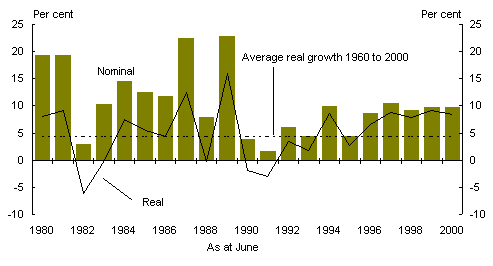
The contributions of the various components of private sector wealth are shown in Chart 2 below.
- In the year to June 2000, the main factor contributing to the growth in private wealth was growth in the market value of dwelling assets, which contributed 6.6 percentage points.
- This was driven by continued growth in established house prices and high levels of dwelling investment.
- The other main contribution to growth in wealth in the year to June 2000 was from net business assets, which contributed 2.8 percentage points.
- Net business assets are defined as domestic business assets held by Australians plus Australian owned assets held abroad, less foreign owned assets in Australia.
- Domestic business assets held by Australians contributed 3.9 percentage points, while Australian investment abroad contributed 2.7 percentage points. These were offset by a 3.9 percentage point subtraction coming from foreign liabilities.
- The rate of growth in the market value of business assets was down from the previous year largely due to weaker growth in stock market prices.
- Smaller contributions came from consumer durables and government securities.
Chart 2: Contributions to growth in nominal
Australian net private sector wealth at market value
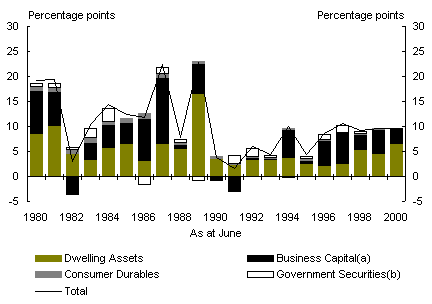
(a) Includes Australian investment abroad and excludes foreign liabilities.
(b) Includes money base.
Valuation ratios for Australian net private wealth
Valuation ratios for individual components of wealth (Table 3) provide a measure of the relationship between the market value and the replacement cost for that component. For dwelling assets, the valuation ratio represents the ratio between the price of established houses and the cost of building new dwellings (inclusive of land). The valuation ratio for business assets is the ratio between the price of existing business assets (as valued by the stock market), and the price of new business investment. The valuation ratio for government securities is determined by current interest rates relative to the interest rates at the time the securities were issued. If there is an unanticipated fall in interest rates relative to the interest rate at the time of issue, then the value of the security rises and vice versa.
Changes in market conditions for particular components of wealth (for example, dwellings) will affect the valuation ratio for that component. Changes in market sentiment and business confidence will lead to changes in individual valuation ratios and fluctuations in the total market value of private sector wealth. The value of wealth at replacement cost is not directly affected by these changes in sentiment or confidence, and hence is more stable.
Chart 3 shows valuation ratios for selected components of wealth.
- The valuation ratio for business assets increased during the year to June 2000, albeit with growth half that in the preceding year. This weaker increase reflected slower growth in stock market prices.
- The valuation ratio for dwelling assets increased during the year to June 2000. This growth was greater than in the preceding year as a result of stronger growth in house prices.
- The valuation ratio for government securities fell at a lesser rate than the preceding year.
Chart 3: Valuation ratios for selected components of wealth
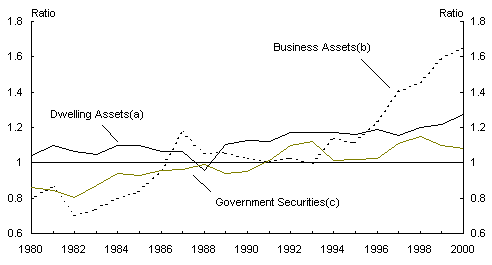
(a) Established house prices divided by the deflator for dwelling investment.
(b) Equity prices divided by the deflator for business fixed investment.
(c) Market price divided by face value.
Composition of Australian net private wealth by type of asset
Chart 4 shows the composition of Australian net private sector wealth (at market value) by asset type as at 30 June 2000. The composition of wealth remained relatively stable during the year, with the share of dwelling assets at around 53 per cent and the share of business assets at around 37 per cent. Government securities represented 6 per cent, consumer durables represented 4 per cent, and the money base represented 1 per cent of the remaining components.
Chart 4: Composition of Australian net private sector wealth
by asset type(a)
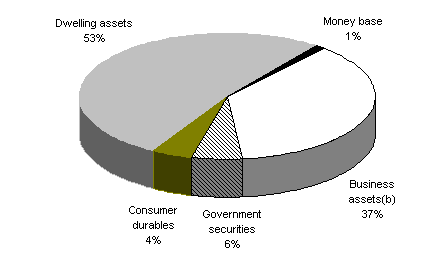
(a) The components do not necessarily sum to 100% due to rounding.
(b) Includes Australian investment abroad and excludes foreign liabilities.
Bilbiography
Bacon, B.R. 1998, Household Wealth and The Aged: An Income Distribution Survey Analysis, Sixth Colloquium of Superannuation Researchers, University of Melbourne, July 1998, Conference Paper No. 3.
Callen, T. 1991, Estimates of Private Sector Wealth, Reserve Bank of Australia, Research Discussion Paper 9109.
Horn, P 1987, Private Non-Human Wealth of Australian Residents in the NIF-88 Model, NIF-88 Background Paper No. 9, December.
Jones, R.S. and Perkins, J.O.N. 1986, Contemporary Macroeconomics, 2nd edn, Prentice-Hall, Sydney.
Modelling Section 1996, `Documentation of the Treasury Macroeconomic (TRYM) Model of the Australian Economy', Treasury, Canberra.
Piggott, J. 1987, The Nation's Private Wealth - Some New Calculations for Australia, The Economic Record, March 1987.
Department of the Treasury 1999, `The Measurement of Saving in Australia', Economic Roundup, Spring 1999, Australian Government Publishing Service, Canberra.
Department of the Treasury 1990, `Private Sector Wealth Estimates in Australia' Economic Roundup, Summer 1990, Australian Government Publishing Service, Canberra.
World Bank 1995, Monitoring Environmental Progress: A Report on Work in Progress, The International Bank for Reconstruction and Development/The World Bank, Washington DC.
Appendix A
Relationship with the ABS national balance sheets
Treasury net wealth estimates presented in this article are broadly consistent with those published in the ABS publication, Australian National Accounts: National Balance Sheet (ABS Cat. 5241.0.40.001). The main differences are that the scope of the Treasury estimates is the aggregate private sector and that the Treasury estimates are prepared using a consistent basis for valuing the assets. In addition, Treasury estimates are available for a much longer time period, thus allowing longer-term analysis of past changes in wealth.
In terms of scope, Treasury estimates cover the total private sector in Australia. In contrast, the ABS balance sheets are prepared for a range of institutional sectors and for Australia as a whole, but not for the private sector as such. In terms of the ABS institutional sector classifications, the private sector is the combination of the ABS household and unincorporated enterprise sector with the private sector components of each of the non-financial corporation and financial corporation sectors.
The major difference is that the ABS estimates include the value of dem
onstrated sub-soil assets and timber in native forests. These assets are not currently included within Treasury estimates due to data limitations. Whereas the ABS estimates for these assets typically only go back to 1989, Treasury wealth estimates are calculated for each year back to 1960.
Another important difference between the ABS and Treasury estimates is the valuation basis that is used. As noted earlier in this article, Treasury estimates are compiled on both a market value and replacement cost basis. In contrast, the ABS uses a replacement cost basis for produced assets and a market value basis for financial assets and liabilities. As a result, the ABS estimates of 'net worth' (or wealth) are actually based on a mix of these two valuation methodologies.
It is possible to reconcile the main components of Treasury estimates of wealth at replacement cost with the estimates of produced assets in the ABS balance sheets, although allowance needs to be made for the differences in scope and coverage. While it is not generally possible to derive estimates of wealth at market value from the ABS balance sheets, it is possible to infer an estimate of the valuation ratio (the ratio of the market value of an asset to its replacement cost) for business assets. This is because the net financial assets held by the combined household and unincorporated, general government and foreign sectors (valued at market prices) should represent claims over the net physical assets held by the financial and non-financial corporation sectors (valued at replacement cost). The ratio so derived is reasonably similar to the valuation ratio for business assets presented in this article, thus confirming that, apart from the scope and coverage issues noted above, Treasury wealth estimates are broadly consistent with the ABS estimates in the national balance sheets.
Table 1(a): Nominal private sector wealth at market value
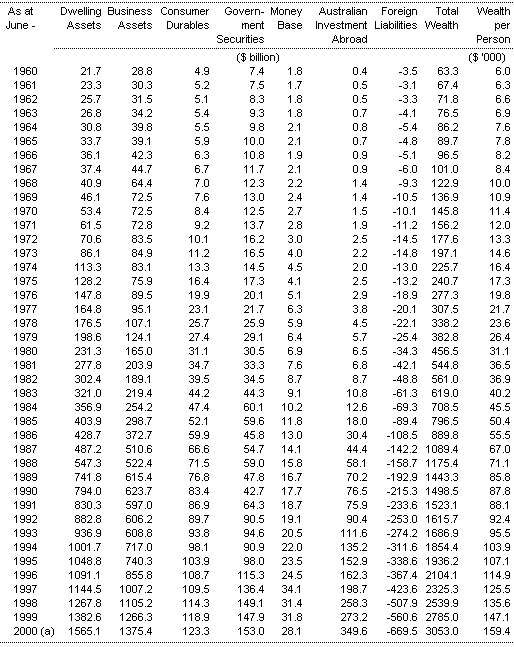
(a) Preliminary figures.
Table 1(b): Real private sector wealth at market value(a)
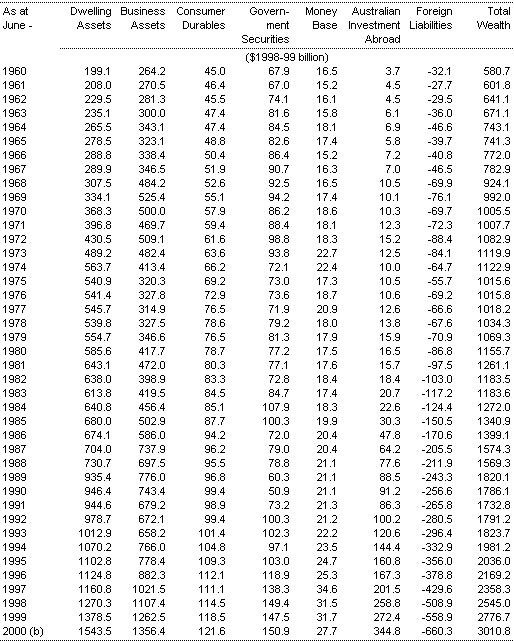
(a) Real wealth is calculated by dividing nominal wealth by the private consumption deflator.
(b) Preliminary figures.
Table 1(c): Real private sector wealth per person at market value(a)
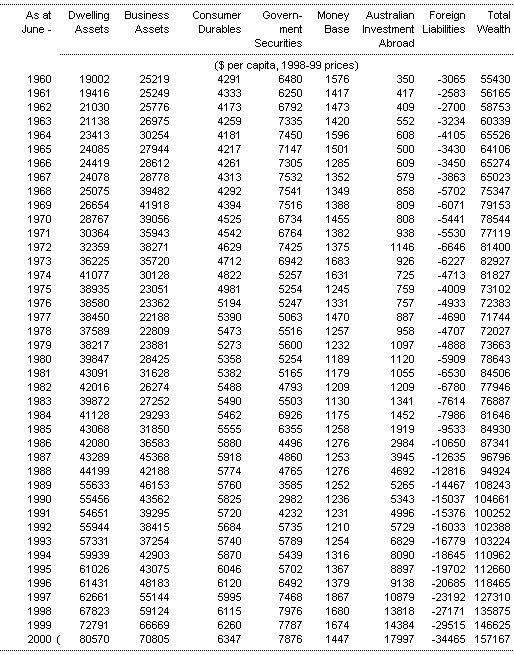
(a) Real wealth is calculated by dividing nominal wealth by the private consumption deflator.
(b) Preliminary figures.
Table 2: Nominal private sector wealth at replacement cost
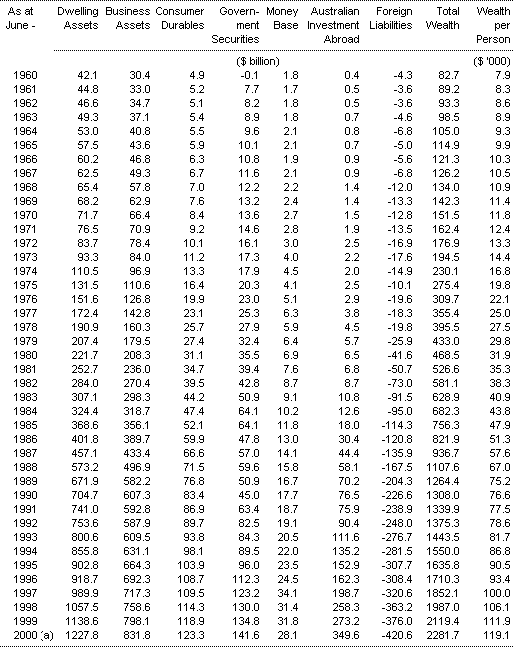
(a) Preliminary figures.
Table 3: Valuation ratios for selected wealth components
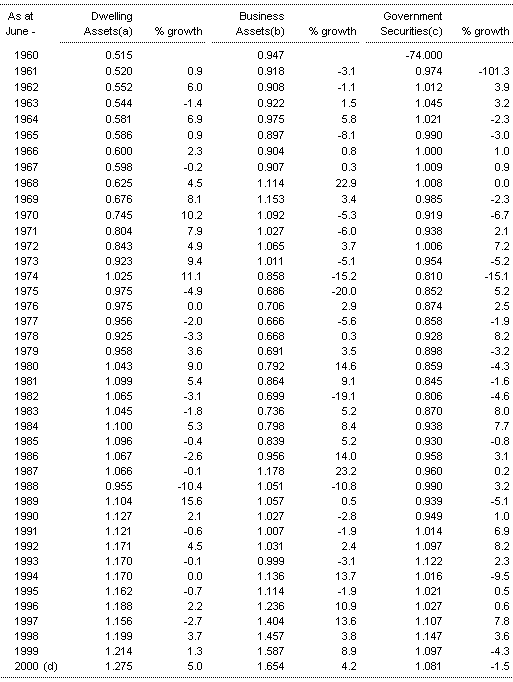
(a) Established house prices divided by the deflator for dwelling investment.
(b) Equity prices divided by the deflator for business fixed investment.
(c) Market price divided by face value.
(d) Preliminary figures.
1 Consolidating the private household and business sectors implies that the bulk of financial instruments held by households (such as bank deposits, debt instruments and superannuation) are netted out in the analysis.
2 Details on assets by sector are available in the ABS publication Australian National Accounts: National Balance Sheet (ABS Catalogue No. 5241.0), and Bacon (1998) discusses household wealth estimates in detail.
3 Other approaches for constructing estimates of wealth include the portfolio and estate methods. Piggott (1987) provides a useful summary of these approaches.
4 The wealth estimates presented in this article measure wealth owned by Australians, regardless of where that wealth is located. For example, an Australian-owned factory located overseas contributes to Australian net private wealth, while an overseas-owned factory located in Australia does not.